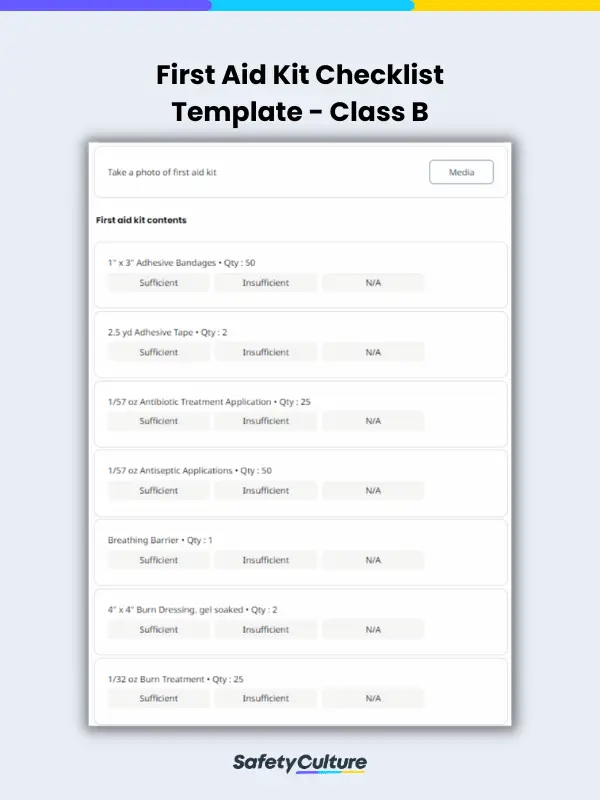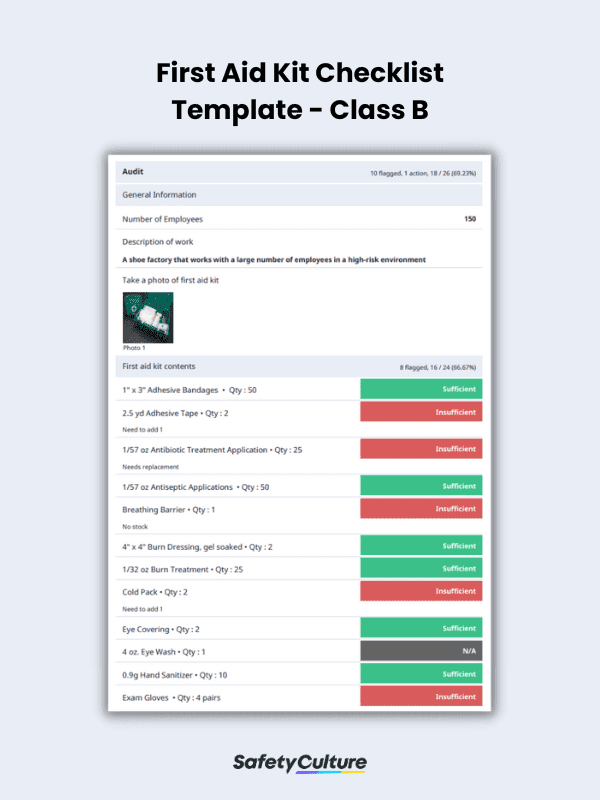What is a First Aid Kit Checklist?
A first aid kit checklist helps guarantee that essential first aid kit contents are within their use-by dates and properly stocked. This inspection tool is used periodically by appointed first aid kit custodians to ensure that proper first aid can be provided in the critical minutes between the occurrence of injury and the arrival of emergency medical service personnel.
Importance
First aid kits are essential in maintaining and promoting workplace safety. In most countries and workplaces, having a first aid kit is mandatory, with regulations such as those from the US Occupational Safety and Health (OSHA) and Safe Work Australia being implemented on how to properly create, store, and use one.
However, each workplace has different needs to consider, hence the need for different first aid kit checklists. A first aid kit checklist is a tool used to log the first aid kit contents. It helps monitor the expiration dates and inventory of stocks, as well as identify the items that need to be replaced or replenished. It serves as a comprehensive guide, ensuring that you have all the necessary items readily available to address injuries, illnesses, or accidents effectively.
Additionally, with a first aid kit checklist, you can also better manage workplace safety. By knowing what items are most commonly used and for what reasons, you can analyze if there is an increase in certain injuries, incidents, and the like.
First Aid Kit Contents
First aid kit contents vary depending on the needs of the business and the risks associated with it. It should be appropriate to cope with a range of emergencies an employee would encounter while performing their tasks.
Following this, a first aid kit checklist can help ensure your kit has the following items:
Wraps, Splints, and Wound Coverings
Slips, trips, and falls are the most common physical hazards in the workplace. It is necessary to have wraps, splints, and wound coverings such as adhesive bandages, splints, and gauze pads in the first aid kits to avoid the aggravation of injuries. A gauze pad is a basic tool used to stop bleeding and keep the wounds clean.
Treatments
Treatments including antibiotic cream, antiseptics, and burn cream are used to destroy some types of bacterial infections. It is necessary to include these in the first aid kit, as they can be used to administer minor cuts, burns, and other skin injuries.
Tools and Supplies
It is important to have ready-to-use tools and supplies including scissors, and tweezers to easily attend injury treatment. Additionally, an adhesive tape is used to hold wound bandages in place and a scissor is for easy cutting. An emergency blanket is utilized when there is thermal radiation, water evaporation, and convection to prevent body heat loss. Resuscitation equipment such as a resuscitation bag, airway, or pocket mask is used to help a patient who is suffering from difficulty breathing.
First Aid Guide
A first aid guide or first aid manual is a quick reference instruction for emergency first aid treatment. It provides background information to manage the incident safely and helps assess an injured person.
How to Build a Suitable First Aid Kit Checklist For Your Workplace
Here are 4 tips on how to create a suitable checklist for your workplace’s first aid box:
Step 1: Perform office risk assessments to identify first aid needs.
Risk assessments, an essential feature of office safety and kitchen safety, allow the company to have an assessment of hazards, risk levels, employee exposure, and first aid response capabilities.
Step 2: Research on first aid kit maintenance best practices in your country.
Generally, local safety regulating bodies do not have strict requirements when it comes to what a first box should contain. Here are some of the best practices in the US, Canada, UK, and Australia.
Step 3: Consult with safety experts, management, and workers.
In addition to research and office risk assessments, it is also helpful to consult with experts and stakeholders to gain more insights into the facilities needed. This consultation can help answer questions on budgets, implementation gaps, and the location where first aid kits are needed.
Step 4: Appoint a specific custodian for first aid kit maintenance.
It is beneficial to have a specific person responsible for maintaining first aid kit contents. Through this, someone can perform monthly inspections and ensure that supplies are adequate and within their use-by dates.
What to Include in a First Aid Kit Checklist?
A typical first aid kit will have fields for the following:
- Describing the type of work the business is associated with
- Inspecting the supplies of the following items:
- Wraps and dressings
- Splints
- Bandages and pads
- Antiseptics
- Gloves
- Hand sanitizer and alcohol
- First aid kit user guide
- Performing a quality check on the contents of the first aid kit
- Providing recommendations
At the end of the checklist, it would be best to include a sign-off section to ensure the validity of the inspection. This can also make it easier to keep track of different inspections done.
Here is a sample first aid checklist kit in use for reference:
FAQs about First Aid Kit Checklists
First aid kits in the workplace can be divided into two types: Class A and Class B. Class A first aid kit checklists are best for organizations with 40 or fewer people and face little to no risk when operating. On the other hand, a Class B first aid kit checklist is more detailed, as Class B first aid kits contain more supplies for addressing more high-risk situations and life-threatening incidents.
A first aid kit checklist is best used during the following situations:
- When bringing or buying a new first aid kit
- When restocking supplies
- When a first aid kit has been used
Regardless of how often you use your first aid kit, you should perform an audit on it regularly with your first aid kit checklist. If you are in a low-risk work environment, you can conduct an audit every once or twice a year, the frequency increasing with the more risks you face. Medium-risk workplaces should conduct audits every three to six months, while for high-risk ones, monthly or weekly audits are recommended.




